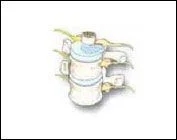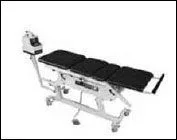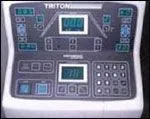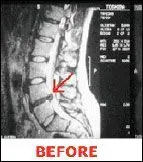What is Spinal Decompression Therapy?
Spinal decompression therapy is FDA cleared and has been clinically proven for pain associated with herniated, bulging or degenerative discs... even after failed surgery. It is a non-surgical, traction therapy for the relief of back and leg pain or neck and arm pain. During this procedure, by cycling through distraction and relaxation phases and by proper positioning, a spinal disc can be isolated and placed under negative pressure, causing a vacuum effect within it.
What can this vacuum effect do?

The vacuum effect accomplishes two things. From a mechanical standpoint, disc material that has protruded or herniated outside the normal confines of the disc can be pulled back within the disc by the vacuum created within the disc. Also, the vacuum within the disc stimulates blood supply, secondarily stimulating a healing response. This results in pain reduction and proper healing at the injured site.

What machine is used for this purpose?
There is a number of spinal decompression machines presently used in the United States. After significant research, Abington Family Chiropractic Center has chosen to use the Triton DTS machine manufactured by Chattanooga, Inc., the premier manufacturer of physical therapy equipment in the world.
How is Spinal Decompression Therapy Different from Regular Traction?

The DTS computer is the key. It controls the variations in the traction allowing for spinal decompression and eliminating muscle guarding and subsequent compression that is typical in conventional traction devices. The preprogrammed patterns for ramping up and down the amount of axial distraction allows for higher levels of spinal decompression and disc rehydration.

Who can benefit from Spinal Decompression Therapy?
Anyone who has back pain or neck pain caused in whole or in part by a damaged disc may be helped by spinal decompression therapy. These conditions include: regenerative, herniated, protruding or bulging discs, spinal stenosis, sciatica or radiculopathy (pinched nerves).
Are there conditions where Spinal Decompression Therapy is not indicated?
Spinal decompression therapy is usually not recommended for pregnant women, or patients who have severe osteoporosis, severe obesity or severe nerve damage. However, every patient is evaluated on an individual basis.
Are there medical studies that document the effectiveness of Spinal Decompression Therapy?
Most certainly! One study documented by MRI up to 90% reduction of disc herniations in 10 of 14 cases! Another study reported that 86% of ruptured disc patients achieved "good" (50-89% improvement) to "excellent (90-100% improvement) results after spinal decompression therapy!
How many sessions will be necessary, what is the cost and are the treatments painful?
The specific treatment plan will be determined by the doctor after your examination and evaluation. Based on CURRENT RESEARCH, the best results have been achieved utilizing a protocol of 24 sessions over an 8-week period. Most insurance companies will cover the treatment. In almost all cases, the treatments are completely painless. In fact, some patients fall asleep during the spinal decompression session.
Do Most Patients Receive Therapy and Rehabilitative Exercises in Addition to Spinal Decompression Therapy?
To reduce inflammation and assist the healing process, supporting structures are treated with passive therapies (ice/heat/muscle stimulation), chiropractic adjustments (as indicated) and/or active rehabilitation in order to strengthen the spinal musculature.
